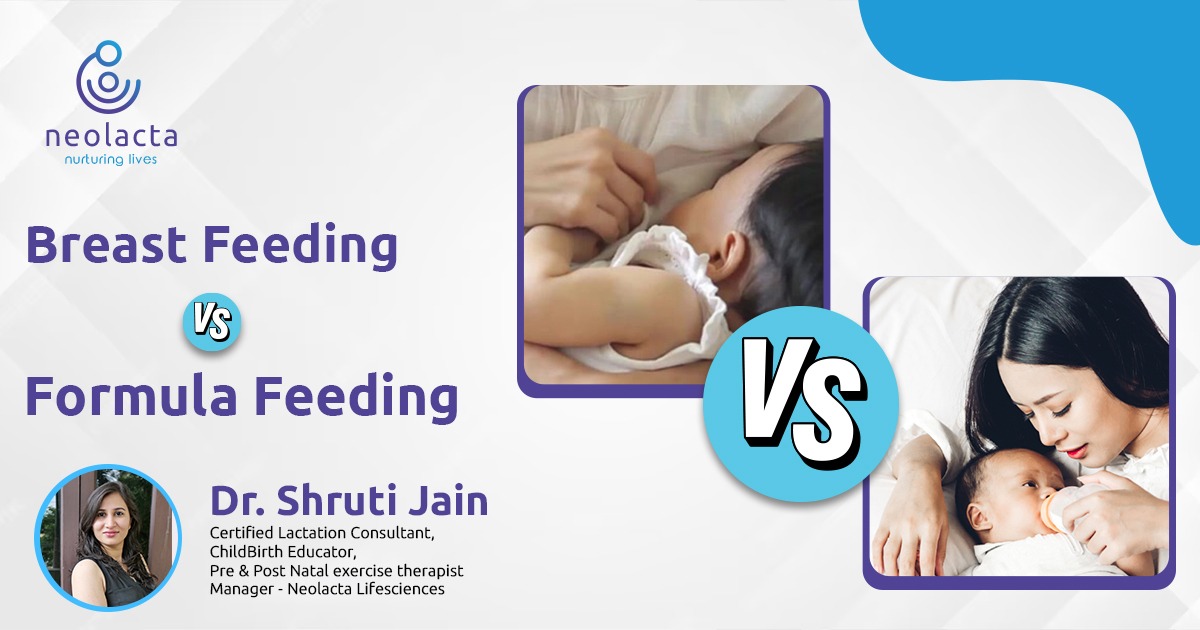Reading Time: 4 minutesBreast is Best – is what most of the pediatricians say due to the benefits of breast milk. Breast milk is designed for human babies and mother’s milk provides all the required nutrients like proteins, minerals and fats to keep the baby hydrated and healthy.
The composition of breast milk and formula
The composition of breast milk and formula have important difference. As formula manufacturing companies try replicating formula with that of mother’s milk it is made of cow’s milk. It is with added nutrients like vitamins, minerals and hydrogenated fats which makes it difficult for the babies to digest.
“Did you know the salt [sodium] content in cow’s milk is pretty much at toxic levels for babies?” says Professor Peter Hartmann, a well know renowned authority associated with the first breast milk bank, Western Australia.
Mothers milk is a living fluid. It generates and adapts to the baby’s changing needs. If mother or her baby is unwell, her body will make antibiotics that will help fight the illness and protect against the infection.
Why not formula milk?
Mostly baby’s formula milk is made of skimmed cow’s milk with added emulsifiers and stabilizers. Fats in formula milk is hard to break and very difficult for the baby to digest. The composition of nutrients varies from brands and country. The most common formula contains:
- Purified cow’s milk whey and casein as a protein source.
- Plant-based oil, such as palm, sunflower and soybean oil as a fat source
- Lactose as carbohydrate source.
- Vitamins and mineral mix
- Amino acids and enzymes
Scientist have shown there are more than 1,000 proteins in breast milk (1) and formula manufactures include one or more of them. This is one of the problems of formula milk why babies do well on formula which lead to higher health risk in the long-term.
The dangers of Infant Formula
- Lack of maternal infection – fighting antibodies.
- Higher risk of developing neocrotizing enterocolitis
- Infant formula takes longer time to digest than breast milk
- Formula-fed babies may have more gas and firmer bowel movements than breastfeed babies.
- Infant formula causes formed, brown stools that have a noticeable odor. Breastmilk causes loose, yellow stools that have less odor.
- Can upset babies stomach.
- Lacks many of the natural benefits of breast milk.
According to a report, India’s formula consumption grew from 24,480 tons to 27,783 tons in the last four years.
In 1991, UNICEF launched the baby-friendly hospital initiative, where hospitals are declared “baby friendly” on meeting a set of criteria that exclusively encourages breastfeeding. However, 25 years later, only 15,000 facilities in 134 countries have been awarded the baby-friendly status.
“From allergies to obesity to asthma, there are great long-term consequences of formula-feeding on public health. Many of the lifestyle diseases that we are looking at today have their roots in infancy. We need to give babies the food meant for them, which is breast milk.”
A research done by Slupsky, Bo Lönnerdal, and their colleagues observed just after four weeks, the formula-fed infants were larger than their breast-fed counterparts, had developed distinct bacterial communities in their gut, had higher insulin levels, and were metabolizing amino acids differently (2).
The formula-fed babies grew quickly—perhaps too quickly—which researchers link, in part, to excess protein. “Parents want their baby to grow but growing too quickly is not such a good thing,” says Slupsky. She hopes her findings will help new mothers and the physicians who advise them to make informed choices about what to feed their babies.
Why only breast milk?
As your baby grows the composition of the milk changes to meet as per the child’s growth. Breastfeed babies receive the most health benefits.
World Health Organization (WHO) recommends exclusive breastfeeding for the first 6 months and gradually introducing other nutrition’s foods at six months along with continued breastfeeding for two years and beyond.
Breast milk helps the babies resist infections and reduce the incidence of serious illness such as,
- Necrotizing Entercolitis (NEC)
- Bronchopulmonary Dysplasia (BPD)
- Sepsis
- Bacterial meningitis
- Ear Infection.
Due to better immunity and brain development breastfeed babies also perform well in school (3), better behavior (4) and eyesight (5). It also prevents them from becoming obese, protect them from Diabetes 1 & 2 (6) & (7).
It also benefits the mother to burn her calories and contracts the uterus and lowers the risk of developing breast cancer (8).
Why Breast milk should be your priority and not Formula?
Breast milk is very economic and readily available. It saves a lot of money and time when a mother breastfeed her baby.
There might be sleepless night as a mother needs to wake up frequently to feed her baby. If a mother starts lactating her baby besides her she can overcome the sleepless night as the baby will sleep faster (right posture is required).
It saves a lot of time for you, there is no need for washing up the bottles, sanitizing, preparing for formula, checking for the right temperature.
Breastfeeding also adds a great value when babies are introduced to solids. Since the food that a mother eat adds flavor to her milk, babies easily get adjusted when introduced them to solids.
The benefits of breast milk are incomparable and cannot be replicated.
Mothers milk, time-tested for millions of years, is the best nutrient for babies because it is nature’s perfect food – Robert S. Mendelsohn
Read more about the benefits of Breast feeding – Benefits of Breast feeding for mother and baby
References:
(1)- https://www.ncbi.nlm.nih.gov/pubmed/25757574
(2) https://pubs.acs.org/doi/abs/10.1021/pr4001702
(3) Straub N et al. Economic impact of breast-feeding-associated improvements of childhood cognitive development, based on data from the ALSPAC. Br J Nutr. 2016;1-6.
(4) Heikkilä K et al. Breast feeding and child behavior in the Millennium Cohort Study. Arch Dis Child. 2011;96(7):635-642.
(5) Singhal A et al. Infant nutrition and stereoacuity at age 4–6 y. Am J Clin Nutr, 2007;85(1):152-159.
(6) Horta B et al. Long‐term consequences of breastfeeding on cholesterol, obesity, systolic blood pressure and type 2 diabetes: a systematic review and meta‐analysis. Acta Paediatr. 2015;104(467):30-37.
(7) Lund-Blix NA. Infant feeding in relation to islet autoimmunity and type 1 diabetes in genetically susceptible children: the MIDIA Study. Diabetes Care. 2015;38(2):257-263.
(8) Dewey KG. Energy and protein requirements during lactation. Annu Rev Nutr. 1997;17:19-36.


